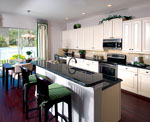
Ashton Woods in The Landings, South Tampa’s award-winning, eco-friendly community with homes from the $100s, offers up to 5 bedrooms and 2,815 square feet.
New Challenges for Green Building
Once considered a fad, green buil-ding has now moved into the mainstream, with more builders focusing on energy efficiency and environmentally sensitive construction and more consumers educating themselves about green alternatives, says Sergio Terzado, chairman for the Tampa Bay Builders Association Green Building Committee.
Economic challenges may blunt that momentum, however, as various green standards become more competitive, and as the housing market struggles to recover, builders say it’s getting tougher to commit to green certification. They say the price tag of some new technologies, as well as the cost of certification, may be too high at a time when home prices, and profit margins, are low.
Plus, adds Terzado, appraisers sometimes don’t understand the value of eco-friendly features.
“It’s a new, emerging technology and appraisers just don’t understand the value of what’s in the house and what it can do,” notes Terzado. “How many appraisers have seen geothermal systems?”
Even homeowners who request green homes don’t always understand the value of green techniques that are less obvious, such as nontoxic construction materials. “It’s an upgrade you can’t see,” Terzado says.
The good news for homebuyers: Energy Star, an Environmental Protection Agency (EPA) certification program, has emerged as a standard that pretty much everyone recognizes and can agree on.
More than 3,500 Energy Star-certified homes have been built in Tampa Bay by builders such as KB Home, M/I Homes and Ashton Woods Homes. In addition, many builders are offering green features as standard in all new homes and others are promoting energy-efficient upgrade packages.
Terzado says Tampa Bay builders and remodelers likely will be “co-mingling” this year on the TBBA Green Building Committee, which means there’ll be plenty
of opportunities for sharing ideas. After all, green remodeling is also emerging as a
major trend as energy-efficient upgrades now rank among the most popular home improvements.
“Look at your home and figure out how to make it more livable and more economical. There are programs out there that help you retrofit,” Terzado says.
If you want to find out how well your home performs, consider an energy audit, he adds.
You can conduct your own assessment online at energysavers.gov, but it makes sense to hire a professional auditor to find problem areas and learn which fixes will save you money both now and over the long term.
Recently, the Obama Administration unveiled a new program offering low-cost energy audits, federally-insured
PowerSaver loans and a new Home Energy Score, developed by the U.S. Department of Energy (DOE). Think of it as a home version of a vehicle’s mile-per-gallon rating.
This is how the Home Energy Score works: A home energy assessor collects information during a walk through the home and uses a Home Energy Scoring Tool to rank the structure on a scale of 1 to 10, with 10 representing top energy performance. Depending upon the ranking, the assessor then provides the homeowner with a list of what repairs and upgrades are recommended as well as anticipated cost savings.
The improvements can be financed under the Federal Housing Adminstration (FHA) PowerSaver pilot program, which offers loans to borrowers with good credit, manageable overall debt and at least some home equity. The maximum loan is $25,000.
The DOE is partnering with counties, utilities and non-profit organizations across the country to test and evaluate the Home Energy Score program through mid- 2011. Then, the process will be refined and launched nationally later in the year.
